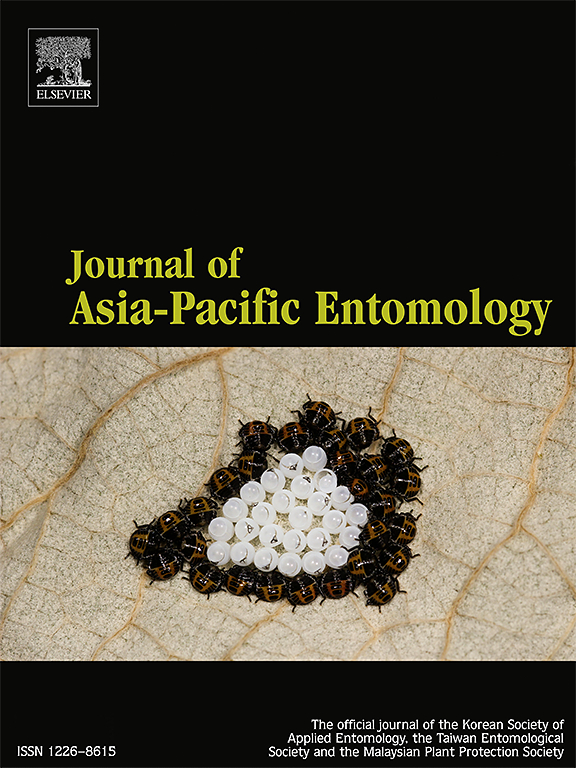Exploring housefly (Diptera: Muscidae) larvae as a sustainable source of oil: A potential non-edible feedstock high in unsaturated fatty acids
IF 1.3
3区 农林科学
Q3 ENTOMOLOGY
引用次数: 0
Abstract
In the quest for innovative alternatives for metabolizable energy, the focus has shifted to the biomass of insect larvae. This study aimed to extract oil from the larval biomass of the housefly (Musca domestica L. 1758, Diptera: Muscidae) and to analyze the oil yield, fatty acid profile, quality indices, infrared spectra, metal concentrations, antioxidant activity, and cytotoxicity using a mouse fibroblast cell line (L929). The results demonstrated that the oil yield extracted from housefly larvae biomass was 26.3 %. The fatty acid profile revealed a high content of monounsaturated fatty acids (50.6 %), polyunsaturated fatty acids (43.9 %), and saturated fatty acids (5.5 %), with oleic acid and linoleic acid as the predominant components. The peroxide index, acidity, and saponification value were measured at 4.30 meq/Kg, 0.021 mg KOH/g, and 0.65 mg KOH/g, respectively, indicating excellent oil quality. Infrared analysis revealed similar functional groups in both the larval biomass and the extracted oil; however, the O–H and C-O functional groups were absent in the oil. The housefly larvae biomass contained essential minerals, including Cu, Fe, K, Na, and Zn. The extracted oil showed low concentrations of potentially toxic elements such as Cr and Ni. Importantly, housefly oil exhibited no cytotoxic effects on healthy cells while reducing reactive oxygen species (ROS) levels and enhancing the activities of superoxide dismutase (SOD) and catalase (CAT) enzymes, highlighting its significant antioxidant potential. Given their chemical compositions, both the housefly larval biomass and oil show promise for applications in human and animal nutrition.

探索家蝇(双翅目:蝇科)幼虫作为一种可持续的油源:一种富含不饱和脂肪酸的潜在的不可食用原料
在寻找可代谢能量的创新替代品的过程中,焦点已经转移到昆虫幼虫的生物量上。本研究以家蝇(Musca domestica L. 1758,双翅目:蝇科)幼虫生物量为原料,利用小鼠成纤维细胞系(L929)对其油脂的产率、脂肪酸谱、品质指标、红外光谱、金属浓度、抗氧化活性和细胞毒性进行了分析。结果表明,家蝇幼虫生物量的油脂提取率为26.3%。脂肪酸谱显示单不饱和脂肪酸(50.6%)、多不饱和脂肪酸(43.9%)和饱和脂肪酸(5.5%)含量高,主要成分为油酸和亚油酸。过氧化指数为4.30 meq/Kg,酸度为0.021 mg KOH/g,皂化值为0.65 mg KOH/g,表明油品品质优良。红外分析表明,幼虫生物量和提取油的官能团相似;油中不存在O-H和C-O官能团。家蝇幼虫生物量中含有Cu、Fe、K、Na和Zn等必需矿物质。提取的油显示出低浓度的潜在有毒元素,如铬和镍。重要的是,家蝇油对健康细胞没有细胞毒性作用,但可以降低活性氧(ROS)水平,提高超氧化物歧化酶(SOD)和过氧化氢酶(CAT)酶的活性,表明其具有显著的抗氧化潜力。鉴于其化学成分,家蝇幼虫生物量和油脂在人类和动物营养方面都有应用前景。
本文章由计算机程序翻译,如有差异,请以英文原文为准。
求助全文
约1分钟内获得全文
求助全文
来源期刊

Journal of Asia-pacific Entomology
Agricultural and Biological Sciences-Insect Science
CiteScore
2.70
自引率
6.70%
发文量
152
审稿时长
69 days
期刊介绍:
The journal publishes original research papers, review articles and short communications in the basic and applied area concerning insects, mites or other arthropods and nematodes of economic importance in agriculture, forestry, industry, human and animal health, and natural resource and environment management, and is the official journal of the Korean Society of Applied Entomology and the Taiwan Entomological Society.
 求助内容:
求助内容: 应助结果提醒方式:
应助结果提醒方式:


